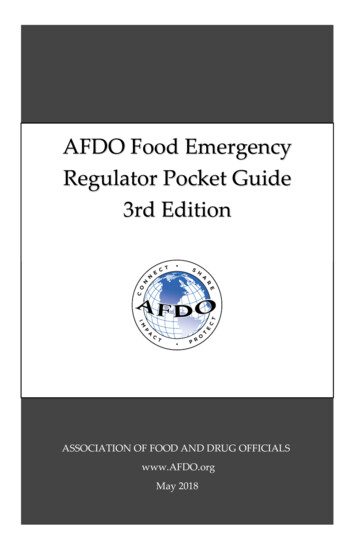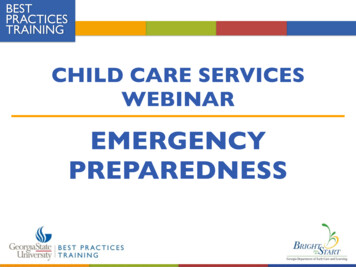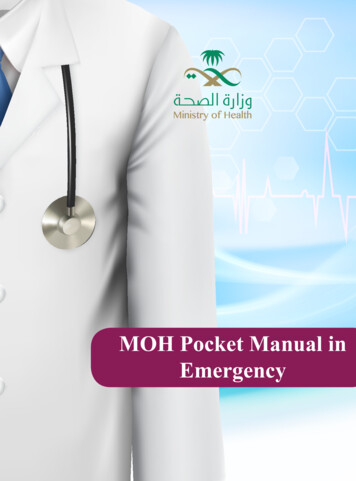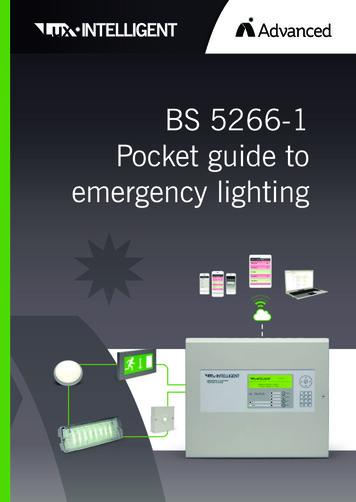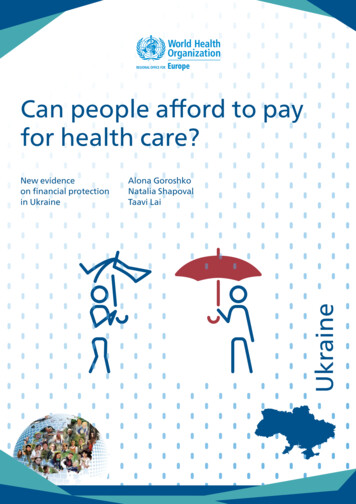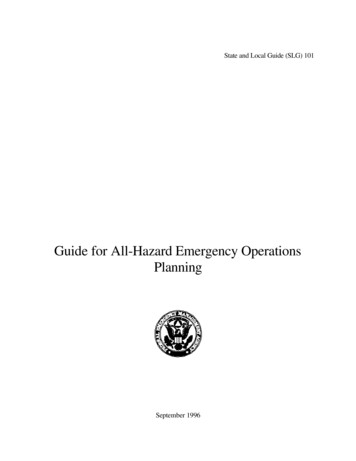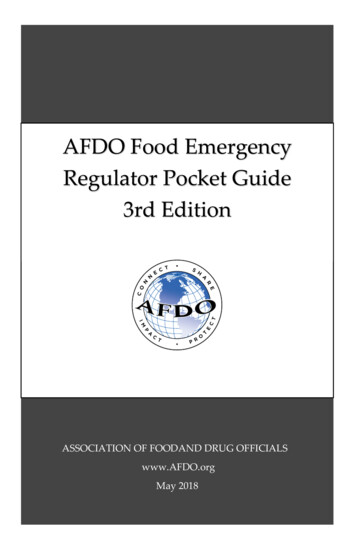
Transcription
AFDO Food EmergencyRegulator Pocket Guide3rd EditionASSOCIATION OF FOOD AND DRUG OFFICIALSwww.AFDO.orgMay 2018
AFDO Food Emergency Regulator Pocket Guide3rd EditionTable of ContentsPreface . 3Purpose. 3Disclaimer . 4Acknowledgements . 4Glossary . 5Emergency Planning . 5Safety . 5Communication . 6Training. 6Equipment/Supplies . 9Imminent Health Hazard . 10Natural Disasters . 11Emergency Response . 12Disrupted Electrical Service . 12Planning. 12Assessment . 13Business Continuity . 15Recovery . 22Interrupted Water Supply . 23Planning. 23Assessment . 24Business Continuity . 26Recovery . 29Contaminated Water Supply (Boil Water Advisory). 31Planning. 31Assessment . 32Business Continuity . 34Recovery . 37Interrupted Gas Service . 39Planning. 39Assessment . 40Business Continuity . 42Recovery . 431
AFDO Food Emergency Regulator Pocket Guide3rd EditionTable of Contents (Continued)Sewage Backup . 44Planning. 44Assessment . 45Business Continuity . 47Recovery . 48Flooding . 50Planning. 50Assessment . 51Business Continuity . 53Recovery . 54Fire . 56Planning. 56Assessment . 57Business Continuity . 59Recovery . 59Pest Infestation . 61Planning. 61Assessment . 62Business Continuity . 63Recovery . 64Food Transport Accident . 66Planning. 66Assessment . 67Business Continuity . 68Recovery . 70Food Product Salvage Guide . 72The Planning “P “ . Back CoverFood Safety Consequence of Disasters Matrix . Back Cover2
AFDO Food Emergency Regulator Pocket Guide3rd EditionPrefaceFrom farm to fork, the food supply chain is vulnerable to potential disastersor emergencies that could impact the safety of food and food products used,sold, or served. Recovery involves necessary steps for food businesses toresume normal operations, thus serving the public by ensuring availabilityof valuable resources. In 2018, the Association of Food and Drug Officials(AFDO) Food Protection and Defense Committee developed this guide toassist Regulators in planning for and responding to disasters oremergencies.This guide was extensively reformatted and replaces the 2011 AFDO FoodEmergency Pocket Guide. The foodborne outbreaks and weapons of massdestruction sections were omitted because they were outside the scope ofthe guide and other resources (i.e. CIFOR, RRT Best Practices Manual, IAFP)are available that describe those responses.To align regulatory and industry responses, this guide is consistent with theEmergency Action Plan for Retail Establishments content and layout. AFDOrecognizes the extensive work done by the Conference of Food Protection’sEmergency Preparedness/Preparedness and Response/Action PlanCommittees of Councils II (2004–2008) and III (2012-2014).PurposeThis guide is intended to aid Food Regulatory programs and addressessome common or unique situations that may require emergency responsesby Food Regulators in the field.This guide references the 2017 Food and Drug Administration (FDA) FoodCode and is consistent with the FDA Code of Federal Regulations (CFR) toprovide uniform regulatory framework with the understanding that eachstate, local, or tribal agency’s statutory authority may vary. For facilitiesunder the United States Department of Agriculture (USDA) Food Safety andInspection Service (FSIS) jurisdiction, this guide is consistent with theguidance in FSIS Directive 5500.2, Significant Incident Response, otherapplicable agency directives and Title 9 Chapter III of the Code of FederalRegulations.3
AFDO Food Emergency Regulator Pocket Guide3rd EditionDisclaimerThis guide and its tools, tables, or charts are not binding requirements. Theinformation provided herein is based on professional experience andpractical considerations as assembled by selected experts within the AFDOmembership. Compliance and enforcement will remain within theinterpretations and decisions of state, local, and tribal authorities.AcknowledgementsAFDO published the first Food Emergency Regulator Pocket Guide in 2004.Beginning in 2017, an AFDO Food Protection and Defense sub-committeeled the effort for revising this 3rd edition. The members of this group are:Jennifer Bonsky, Michigan Department of Agriculture and Rural DevelopmentApril Hunt, JD, Michigan Department of Agriculture and Rural DevelopmentMark S. Miklos, CP-FS, National Restaurant AssociationJennifer Pierquet, MPH, Iowa Department of Inspections and AppealsBrandon Sauceda, MPH, Georgia Department of AgricultureHannah Szegedy, Michigan Department of Agriculture and Rural DevelopmentTodd Rossow, CP-FS, Publix Super Markets, Inc.The Committee is grateful to the following organizations and agencies fortheir assistance in updating and enhancing this guide:American Gas AssociationBoulder County Public Health DepartmentGeorgia Department of AgricultureIowa Department of Inspections and AppealsMichigan Department of Agriculture and Rural DevelopmentNational Restaurant AssociationNorth Carolina Department of Agriculture and Consumer ServicesPennsylvania Department of AgriculturePublix Super Markets, Inc.United States Department of AgricultureAFDO also appreciates the assistance of all those who reviewed this guide.4
AFDO Food Emergency Regulator Pocket Guide3rd EditionGlossaryAFDO – Association of Food and Drug OfficialsATF - Alcohol, Tobacco, Firearms and ExplosivesCFR – Code of Federal RegulationsEMI – Emergency Management InstituteFDA – Food and Drug AdministrationFEMA – Federal Emergency Management AgencyFBI – Federal Bureau of InvestigationsFC – 2017 FDA Food CodeFSIS – (USDA) Food Safety and Inspection ServiceHVAC – Heating, ventilation and air conditioningICS – Incident Command SystemNIMS – National Incident Management SystemNOAA – National Oceanic and Atmospheric AdministrationOSHA – Occupational Safety and Health AdministrationPIC – Person in ChargePPE – Personal Protective EquipmentRRT—Rapid Response TeamsTCS – Time/Temperature Control for SafetyT/T – Time and TemperatureUSDA – United States Department of AgricultureEmergency PlanningAll hazards, emergencies, and disasters, whether natural or manmade,accidental or intentional, have potential to cause adverse health and safetyimplications for large segments of human and animal populations. Disastersmay include hurricanes, flooding, tornados, or storm events that can resultin an emergency, such as extended loss of power, interruption in waterservice, or fire. To mitigate the effects of such incidents, regulators mustpossess the knowledge, resources, and capabilities necessary to prevent,prepare for, rapidly respond to, and assist in recovery from all hazards. Thisis accomplished through planning and preparation, as Aristotle famouslystated, “Well Begun is Half Done”.SafetyDuring all responses, safety of regulators and the public is the primaryobjective. If regulators are operating under the Incident Command System(ICS) structure, the Safety Officer will address safety hazards and mitigationstrategies. Otherwise, field staff and supervisors must address hazards thatstaff may experience, including a combination of chemical, biological,5
AFDO Food Emergency Regulator Pocket Guide3rd Editionphysical, ergonomic, mental health, and stress hazards. In instances whenpersonal protective equipment (PPE) is required to ensure safety during anemergency response, then equipment must meet industry and safetystandards and be properly calibrated and “fitted” to the regulator prior tothe event. A safety note is included in each response section of this guide.CommunicationEffective communication during responses enhances the accuracy andefficiency with which we respond, however during emergencies, clear andtimely communication between regulators and other key personnel can be achallenge. Field staff must know to contact their supervisor when madeaware of an emergency and to report their status. During emergencies,regulators may be affected by phone outages or overloaded cellular systemsand may be unable to communicate with their office. These circumstancesnecessitate a preestablished Agency Communication Plan. Agency Communication Plan Considerations:Identify internal and external response and regulatory partners at federal,state, local, and tribal levels. Include law enforcement contacts forintentional food contamination or if tampering is suspected. To reportsuspicious activity, call 855-TELL-FBI or 855-835-5324.Maintain current and readily available contact information for businesshours and after-hours. Identify backup contacts.Establish procedures and call-trees for notifying response personnel.Identify meeting locations for field staff for times when phone or e-mailcommunication cannot be made.Establish phone numbers, for the public or industry, separate frominternal department communication phone numbers.Identify staff to handle excessive calls from the public or field.Review and update the plan at least annually.TrainingTraining is crucial in preparing field staff to respond effectively, therefore,this section provides best practices and recommended training strategiesthat may enhance an Agency Training Plan. Regulators must consult theiragency training officer to ensure state and federal training standards aremet. After completing agency training, regulators should completecontinuing education in emergency response courses and the IncidentCommand System (ICS) courses sponsored by Federal EmergencyManagement Agency (FEMA).6
AFDO Food Emergency Regulator Pocket Guide3rd Edition Minimum Recommended Online ICS Courses for Responders:ICS 100 – Introduction to the Incident Command SystemICS 200 – ICS for Single Resources and Initial Action IncidentsICS 700 – National Incident Management System, an IntroductionICS 800 – National Response Framework, an IntroductionRegulators that serve in a leadership role and/or as ICS Command andGeneral Staff should complete the following: Recommended Classroom ICS Courses:ICS 300 – Intermediate ICS for Expanding IncidentsICS 400 – Advanced ICS for Command and General StaffAll-Hazards Position Specific Courses – (Operations Section Chief,Planning Section Chief, etc.)The Emergency Management Institute (EMI) within FEMA provides onlineNational Incident Management System (NIMS) courses free of charge and aschedule of classroom courses at, www.training.fema.gov/nims. Regulatorsmay consider attending FEMA’s Center for Domestic Preparedness Environmental Health Training in Emergency Response to advance theirskills.Emergency Response Training Considerations:Initial orientation of new responders.Formal classroom and on-the-job training in food inspection, sampling,epidemiological investigation, traceback, ICS, safety, and otherfoodborne outbreak investigations and technical inspection proceduresas identified.Feedback from past responses, after-action reports, and debriefs.Mentoring of new responders by experienced senior member.Team-oriented training with federal, state, and local partners.7
AFDO Food Emergency Regulator Pocket Guide3rd EditionPlanning “P”Strategic response planning lends itself to more efficient use of resources,useful strategies and tactics, improved safety, lower response costs, andincreased overall response effectiveness. The Planning “P” guides theplanning process during ICS responses, but it is also recommended as a toolto assist in planning for other responses, especially those involving multiplefacilities, jurisdictions, or agencies.Figure 1 Planning 30726-1822-25045-815/incident action planning guide 1 26 2012.pdf8
AFDO Food Emergency Regulator Pocket Guide3rd EditionEquipment/SuppliesHaving proper supplies during an emergency will allow for a more efficientand equipped field staff. The following list provides some items that shouldbe available to field regulators during food emergencies.Recommended Responder Equipment:Disaster policies and protocolsEmergency contact listsCredentials and identificationInspection/investigation, seizure/embargo, chain of custody formsLaptop, tablet, camera, mobile phone with internet access and chargerFlashlight with extra batteriesThermometers – analog and digital, infrared if availableSpecimen collection kits (food, water, clinical)Tamper resistant labeling tape or duct tapeMult-iuse tool or pocket knifeActivity reports or log book (ICS214)Equipment supply requisitions and logsNote pad, pens, pencils, permanent markersPersonal Protective Equipment (PPE): Helmet or head gear, coveralls,boots, nitrile gloves, dust particulate masks, safety goggles, and hearingprotectionDrinking waterCash (for personal meals and other expenses)Anti-bacterial and alcohol wipesFirst aid kitPlastic garbage bagsSanitizer concentration testing kitsBackup batteries for electronics9
AFDO Food Emergency Regulator Pocket Guide3rd EditionImminent Health HazardThe 2017 FDA Food Code defines Imminent Health Hazard as “a significantthreat or danger to health that is considered to exist when there is evidencesufficient to show that a product, practice, circumstance, or event creates asituation that requires immediate correction or cessation of operation toprevent injury based on:(1) The number of potential injuries, and(2) The nature, severity, and duration of the anticipated injury. “Cease Operation and Reporting (FC 8.404.11)(A) Except as specified in ¶ (B) and (C) of this section, a permit holder shallimmediately discontinue operations and notify the regulatory authority ifan imminent health hazard may exist because of an emergency such as afire, flood, extended interruption of electrical or water service, sewagebackup, misuse of poisonous or toxic materials, onset of an apparentfoodborne illness outbreak, gross insanitary occurrence or condition, orother circumstance that may endanger public health.(B) A permit holder need not discontinue operations in an area of an establishmentthat is unaffected by the imminent health hazard.(C) Considering the nature of the potential hazard involved and the complexity ofthe corrective action needed, the regulatory authority may agree to continuingoperations in the event of an extended interruption of electrical or water service if:(1) A written emergency operating plan has been approved;(2) Immediate corrective action is taken to eliminate, prevent, or control anyfood safety risk and imminent health hazard associated with the electrical orwater service interruption; and(3) The regulatory authority is informed upon implementation of the writtenemergency operating plan.Resumption of Operations (FC 8-404.12)If operations are discontinued as specified in Food Code § 8-404.11 orotherwise according to law, the permit holder shall obtain approval fromthe regulatory authority before resuming operations.10
AFDO Food Emergency Regulator Pocket Guide3rd EditionNatural DisastersNatural disasters, such as earthquakes, flooding, or tornadoes, can strikewithout warning and Regulatory Agencies must be ready to respondaccording to the needs of the community. This guide describes responseactions that can be applied to many natural disasters. To provide furtherdirection on natural disaster responses, this guide offers a disaster riskassessment tool. The Food Safety Consequences of Disasters Matrix listshigh level consequences for a variety of natural disasters and correspondingrisk aggregated from a survey of State Rapid Response Teams (RRTs), assupported by FDA. Each box is labeled with a number and color thatcorresponds to the risk key. The matrix may give agencies a sense of whatnatural disasters to prepare for based on the likelihood of severeconsequences. Agencies may consider customizing the matrix as apreparedness exercise. Note: Color coding in the chart below is to help regulatorsvisualize increasing risk and does not coordinate with color coding in this Guide.Figure 2 Food Safety Consequences of Disasters Matrix (also on back cover)11
AFDO Food Emergency Regulator Pocket Guide3rd EditionEmergency ResponseDisrupted Electrical ServiceDuring a sustained interruption of electrical service, a Food Safety Regulatorresponse needs to ascertain the extent of the outage and assess food safety handlingpractices at affected facilities. Brief interruptions that do not impact food safety maynot require a regulatory response. However, if there is a large scale or extended lossof power, regulators will respond to determine if an Imminent Health Hazard exists.Regulatory Agencies should consider the following factors when planning responsesto major power outages, and prior to assigning responders.1. Has there been an evacuation or other order that would require the public(including regulators) to leave the area?2. Can Responders safely travel to facilities and safely conduct assessments?3. Are alternative procedures or backup communication systems available?4. Is there a set of assessment questions that all responders should be asking?During a large-scale response, a regulatory agency will likely need to prioritizeefforts based on risk. The example below shows risk on an increasing scale:Firm notaffectedLowest RiskFirm in affectedarea;Firm in affectedarea;Firm in affectedarea;Pre-approvedemergency planUnapprovedemergency planNo emergencyplanHighest RiskPlanningDisruptions in electrical service, or extended power outages are one of themost common emergencies that impact food establishments. Power outagesmay be short, lasting only a few minutes or hours, but in some cases, thepower loss may continue for several days. Pre-incident planning betweenregulators and industry helps ensure firms are prepared and therefore,considered lower risk. Regulators should encourage facilities to developemergency action plans for electrical interruptions that include specificdetails for how the firm will maintain food safety, how and wheretemperatures will be taken, frequency for monitoring, and how thetemperatures will be recorded. Food Regulators may review or pre-approvean emergency plan to ensure it addresses issues and decisions the firm willhave to make and minimizes uncertainty when a power outage occurs.12
AFDO Food Emergency Regulator Pocket Guide3rd EditionDisruption of Electrical Service – Facility Plan Considerations: Identify primary decision maker, Person in Charge (PIC) (FC 2-101.11). Contact power company to determine expected duration of outage. Obtain equipment and supplies such as generators, alternate lighting(may need locality approval), refrigerated trucks, totes to store food, plasticto wrap food, dry ice, etc. Provide a first aid kit with necessary items. Plan for safe operations during the outage, including:o identify food departments that will remain open,o sell only shelf-stable foods, bottled water, non-food items, oro close completely. Maintain or minimize temperature loss (FC 3-501.16):o Identify which refrigerated cases to protect with insulated cardboard,covers, or tarps.o Identify which refrigerated product to transfer to refrigerated trailers,freezers, or offsite storage.o Assign extra employees to cover or move all food products.o Use dry ice. Routinely monitor and record temperatures for refrigeration units, freezerunits, and product during storage and transport (FC 2-103.11 (I)) with anapproved thermometer (FC 4-203.11). Identify action levels for disposing of Time/Temperature Control forSafety (TCS) foods due to improper temperatures (FC 3-501.18):o Provide dumpster or compactor for large disposalo Contract company for disposal beyond current capacity.If a firm has a plan to address the above issues, classify them as lower riskand focus response efforts on higher risk firms lacking a plan.AssessmentEmergency response assessments during a disruption of electrical servicedetermine whether PICs are ensuring safe operations, especially that TCSfoods are safe to hold, sell, or serve. These assessments consider how thenature of the power outage and anticipated duration may impact the firm’sability to manage food safety. If Regulators identify unsafe operations, theunsafe foods are removed from commerce and cease operations orders areissued in accordance with state or local law or Food Code (FC 8-404.11).13
AFDO Food Emergency Regulator Pocket Guide3rd EditionNature, Scope, and DurationThe nature and scope of an outage will determine the type and complexityof regulatory authority response. Power outages can be placed into one ofthree broad categories:Short term orlocalized Does not disrupt community infrastructure Affects one facility or limited area Short duration-less than four hours Regulator responds to facility notifications orconsumer complaintsLarge area; nodisruption ofcommunityinfrastructure May be of unknown duration Affect multiple facilities in an area Regulators conduct extensive coordinatedresponse based on riskLarge area;disruption ofcommunityinfrastructure Longer anticipated duration due to storms,floods, fires and earthquakes Regulators conduct extensive coordinatedresponse based on risk May need alternate communication methods May have to assess other emergency categories(i.e. water interruption) concurrentlySafetyRegulator safety is priority no matter the incident size, nature, or scope.Safety Note: Never enter an area or perform any job task that will resultin injury or illness. Upon arrival at an emergency or disaster, check with theFire Chief, Police Officer, or Incident Commander to determine safety of thesite. If the building is standing, find out when it will be safe to enter andattempt to contact the owner. If damage is extensive, approval from the firedepartment or city building inspector may be required prior to entering thebuilding or area.Exercise care to eliminate the chance of injury. Wear protective clothing, i.e.helmet, coveralls, safety goggles, boots, etc. and use a flashlight asappropriate. Look for damaged ceilings and roof supports, weak floors, anddowned power lines. If electrical service is still on in the building, bewatchful for loose or exposed wiring. Consider having the firm contact thepower company or local authorities to shut-off the power. If there areconcerns about in-facility safety, then contact supervisor or Safety OfficerIMMEDIATELY.14
AFDO Food Emergency Regulator Pocket Guide3rd EditionFood Safety ConsiderationsDuring a power outage, the primary concern for the Regulatory Authority isto quickly assess the operation (or many operations), to verify the following:1. No imminent health hazard is present. (FC 8-404.11).2. PIC is ensuring that the firm is safely operating during the powerinterruption, especially that TCS foods are being handled, stored, ordisplayed properly. (FC 2-103.11).If either of the above items cannot be demonstrated, then order closure ofthe establishment or limit operations until they are safely resumed.However, if the impact is not too severe, then continued operation may beapproved, pending initial and continued demonstration of food safetypractices. If the firm is operational, then the firm’s emergency operationalsystem and equipment impacted by the power outage will have to beassessed, focusing on the following:1. TCS foods in the event of a loss of refrigeration, hot-holding, or cookingequipment. (FC 3-501).2. Temperatures of refrigerated units which are most vulnerable to coldtemperature loss, such as open or upright cases.3. Functionality of water heaters, lighting, refrigeration systems, icemakers, food/beverage dispensing systems, cooking/heating equipment,dish washing machines, sensor-activated handwashing sinks, handdryers and other equipment/systems (food processing or food servicerelated equipment) that will most likely be inoperative unless otherpower sources are available.Business ContinuityIf an affected firm intends to continue operations throughout an outage, andthey do not have a pre-approved emergency action plan to follow, then theRegulator must verify that the firm is able to demonstrate safe practices. Inmost cases, this is accomplished by following temporary emergencyprocedures that have been approved by the Regulatory Authority during anassessment.Emergency Procedures:Refrigeration EquipmentIf the firm wants to continue holding, or selling TCS food, then the PIC mustdemonstrate that the following crite
This guide is intended to aid Food Regulatory programs and addresses . AFDO published the first Food Emergency Regulator Pocket Guide in 2004. . The Planning “P” guides the planning process d
